No hot water can turn your morning routine into a shocking wake-up call. If you've jumped into an unexpectedly cold shower, you're dealing with one of the most common household emergencies.
Quick Diagnosis for No Hot Water:
Most water heaters last about 10 years, but they can fail suddenly due to electrical issues, gas supply problems, or component wear. The most likely culprits for complete hot water loss are no electric power or a burned-out upper heating element in electric units, while gas heaters typically fail when the pilot light goes out or the thermocouple malfunctions.
Understanding whether you have a gas or electric water heater is your first step toward getting hot water flowing again. Gas units rely on a pilot light and burner system, while electric models use heating elements controlled by thermostats and circuit breakers.
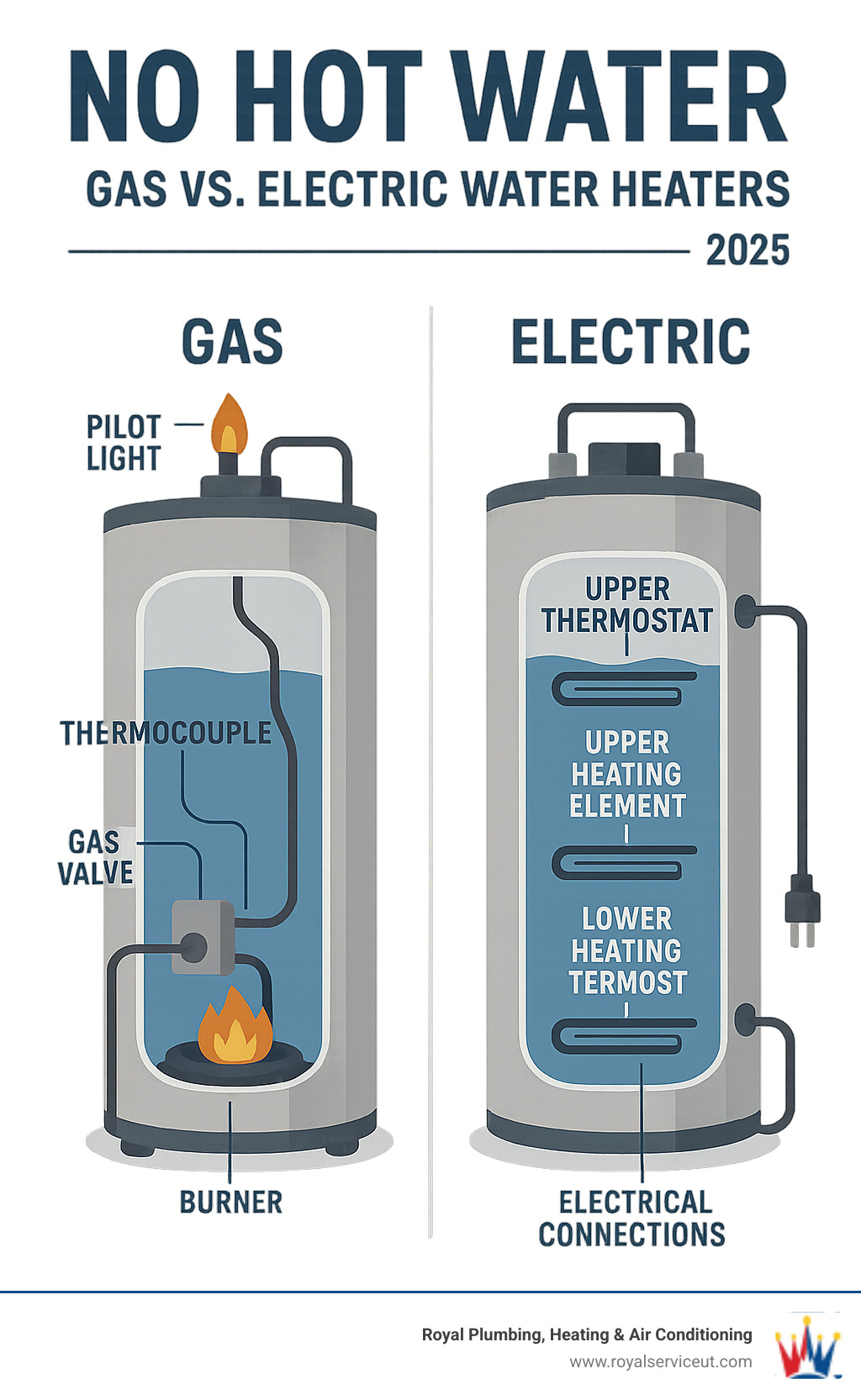
When you're dealing with no hot water, your first instinct might be to start poking around your water heater immediately. Hold on there! Before we turn you into a DIY hero, let's talk safety first. Water heaters are basically large appliances that combine electricity (or gas) with hot water – and that's a combination that demands respect.
Electrical shock is a real danger with electric water heaters, especially when water is involved. For gas units, we're dealing with potential gas leaks, which can be extremely dangerous. The good news? A little caution and the right approach will keep you safe while you troubleshoot.
You don't need a garage full of tools to diagnose most water heater problems. A simple toolkit will get you through most situations: a multimeter for testing electrical connections, basic screwdrivers for removing access panels, an adjustable wrench for checking connections, and a good flashlight because water heaters love hiding in dark corners of basements and utility rooms.
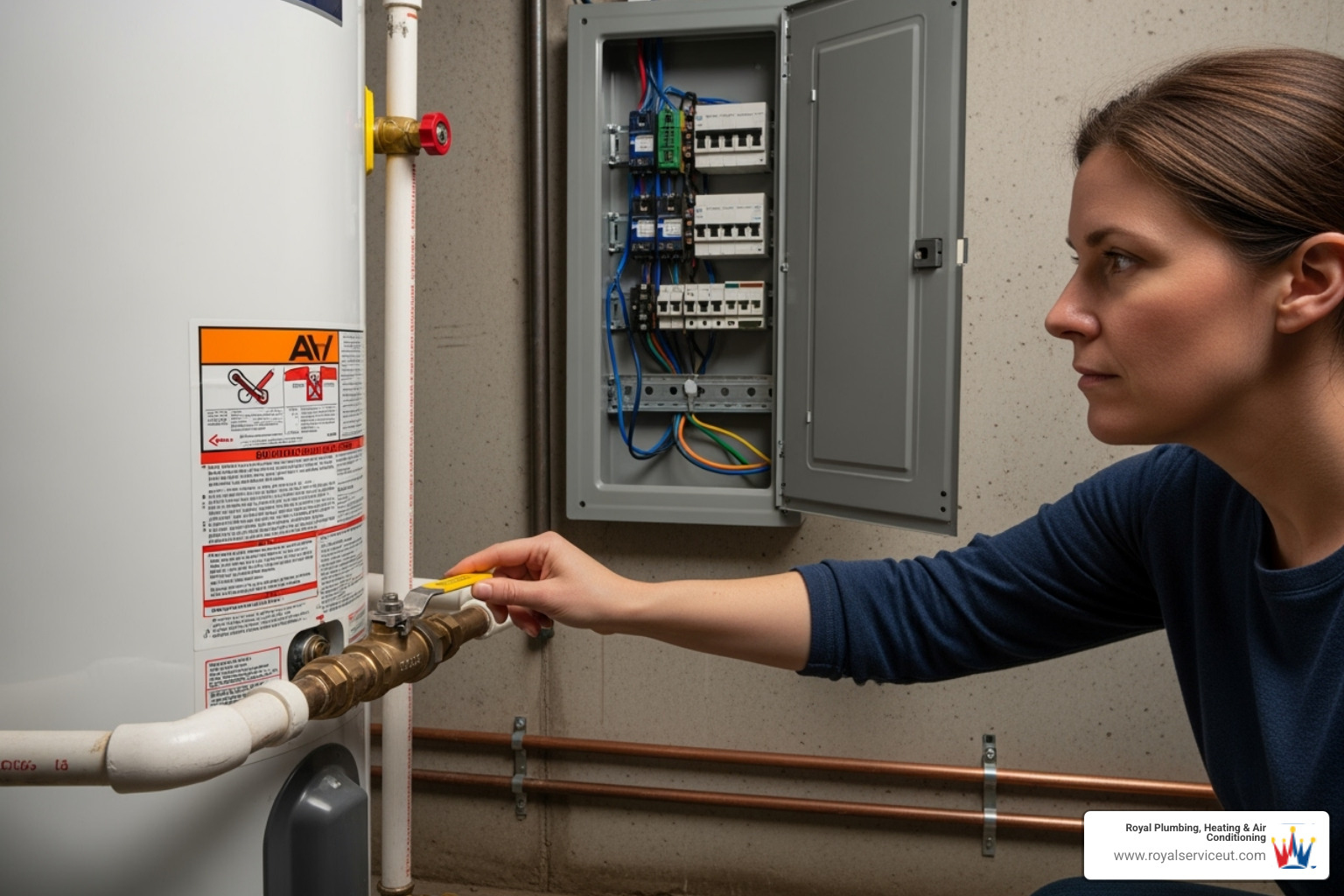
Here's the truth: most no hot water situations come down to power problems. It's not glamorous, but checking your power source first can save you hours of unnecessary troubleshooting.
For electric water heaters, head straight to your home's circuit breaker panel. Look for the breaker labeled "water heater" – it's usually a double-pole breaker that looks bigger than the standard ones. If it's tripped, you'll see it sitting in the middle position or flipped to "off." Reset it by pushing it fully to "off" first, then back to "on."
If that breaker keeps tripping after you reset it, don't keep flipping it back on. That's your electrical system telling you something's wrong, and continuing to reset a tripping breaker can be dangerous. In older homes with fuse boxes instead of breakers, look for a blown fuse – you'll usually see a blackened window or melted metal inside.
Gas water heaters need their fuel supply, so check the gas supply valve on the line leading to your unit. This valve should be parallel to the pipe when it's open. If it's perpendicular, it's closed. While you're at it, test whether your other gas appliances like your stove or furnace are working – if they're not, you might have a broader gas supply issue.
Your water heater's thermostat is like the brain of the operation, deciding when to heat water and how hot to make it. When you have no hot water, the thermostat is often the culprit.
Find your thermostat – on gas units, it's usually part of the gas control valve on the front. Electric water heaters typically have two thermostats behind small access panels. Check that the temperature dial is set appropriately. The ideal setting for your thermostat is around 120°F (49°C) – hot enough for comfortable showers but not so hot that it wastes energy or risks scalding.
Many electric water heaters have a high-temperature cutoff switch as a safety feature. When the water gets too hot, this switch trips and cuts power to prevent overheating. Look for a small red reset button near the upper thermostat. If your electric unit has no hot water, try pressing this button once. If it immediately pops back out or you find yourself pressing it repeatedly, you've got a deeper problem that needs professional attention.
Sometimes the fix really is this simple – a tripped reset button or an accidentally adjusted thermostat can leave you shivering in a cold shower when the solution is just a button press away.
Electric water heaters might seem mysterious, but they're actually pretty straightforward once you understand how they work. Think of them like giant electric kettles with two heating elements and a couple of thermostats keeping everything running smoothly. When you're dealing with no hot water from an electric unit, the problem usually boils down to one of these electrical components calling it quits.
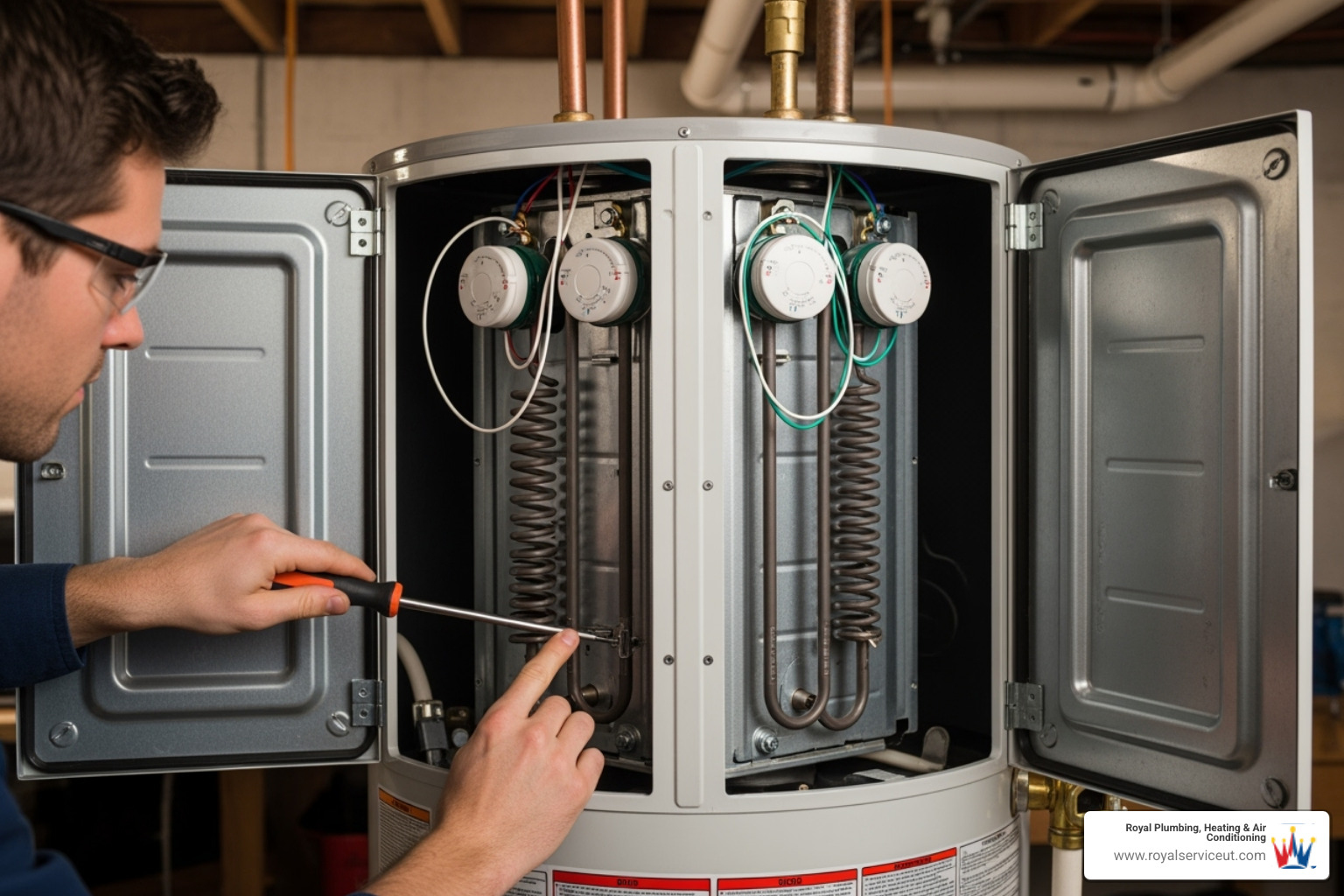
The good news? Most electric water heater problems have clear symptoms that point you in the right direction. The challenging part is that working with electricity requires extra caution and sometimes specialized tools like a multimeter to properly diagnose issues.
When your electric water heater stops producing hot water entirely, you're usually looking at one of several common problems. Let's walk through each one so you can identify what might be happening in your situation.
A tripped circuit breaker is still the most likely suspect, even if you've already checked once. Electric water heaters are power-hungry appliances, and sometimes a breaker can appear to be "on" when it's actually tripped partway. Make sure to flip it completely off before switching it back on. If the breaker keeps tripping repeatedly, though, that's your water heater's way of saying "something's not right in here" – and it's time to call a professional.
Thermostat problems can be particularly tricky because electric water heaters have two of them. The upper thermostat acts like the boss, controlling both heating elements in sequence. When it fails, you often get no hot water at all. The lower thermostat is more of a follower, and when it goes bad, you might still get some hot water, just not enough to satisfy your household's needs.
The high-limit switch – that little red reset button we mentioned earlier – is basically your water heater's emergency brake. It trips when things get too hot inside the tank, which can happen if a thermostat gets stuck or a heating element develops a short circuit. If pressing the reset button doesn't solve your no hot water problem, or if it immediately pops back out, something else is causing the overheating.
Burnt-out heating elements are probably the most common reason for complete hot water loss in electric units. Here's something many homeowners don't know: if you ever have your water heater replaced, make sure the installer fills the tank completely before turning on the power. Running electricity through a heating element when it's not surrounded by water – called "dry firing" – will destroy it in minutes.
For complex electrical diagnosis and repairs, especially when you're not comfortable working around high voltage, our team can help with electric water heater repair to get your hot water flowing safely again.
Heating elements don't always fail dramatically – sometimes they give you warning signs before they completely give up. Learning to recognize these symptoms can help you catch problems before you're stuck with no hot water on a busy morning.
Lukewarm water is often the first sign something's wrong with a heating element. Since electric water heaters typically heat from the top down, a failed upper element might leave you with only the small amount of hot water that the lower element can manage. It's like trying to fill a swimming pool with a garden hose – technically possible, but not very practical for your morning shower.
Complete hot water loss usually means either both elements have failed or the upper element (which controls the heating sequence) has burnt out. This is when you get that unpleasant cold shower surprise.
Strange sounds from your water heater can indicate a struggling heating element. You might hear hissing, crackling, or popping sounds as mineral deposits around a failing element heat up and cool down. These sounds are often more noticeable when sediment has built up around the elements.
A suddenly higher electric bill might seem unrelated, but failing heating elements sometimes draw more power as they struggle to do their job. If your electricity usage spikes without explanation, your water heater could be working overtime with faulty components.
Testing with a multimeter gives you the definitive answer about element condition. After turning off power at the breaker and removing the element's wire connections, you can test for continuity. A working element will show resistance (usually between 10-16 ohms), while a burnt-out element shows no continuity at all. If you're not comfortable using electrical testing equipment, this is definitely a job for a professional.
Gas water heaters are wonderful when they work, but when you're facing no hot water, the problem usually comes down to one thing: either your pilot light went out, or something's blocking the gas from flowing properly. The good news? Many gas water heater issues are actually easier to fix than electric ones, once you know what to look for.
Your gas water heater depends on a delicate dance between the pilot light, thermocouple, gas control valve, and burner assembly. When any one of these components decides to take a break, you'll find yourself with cold showers and a lot of frustration.
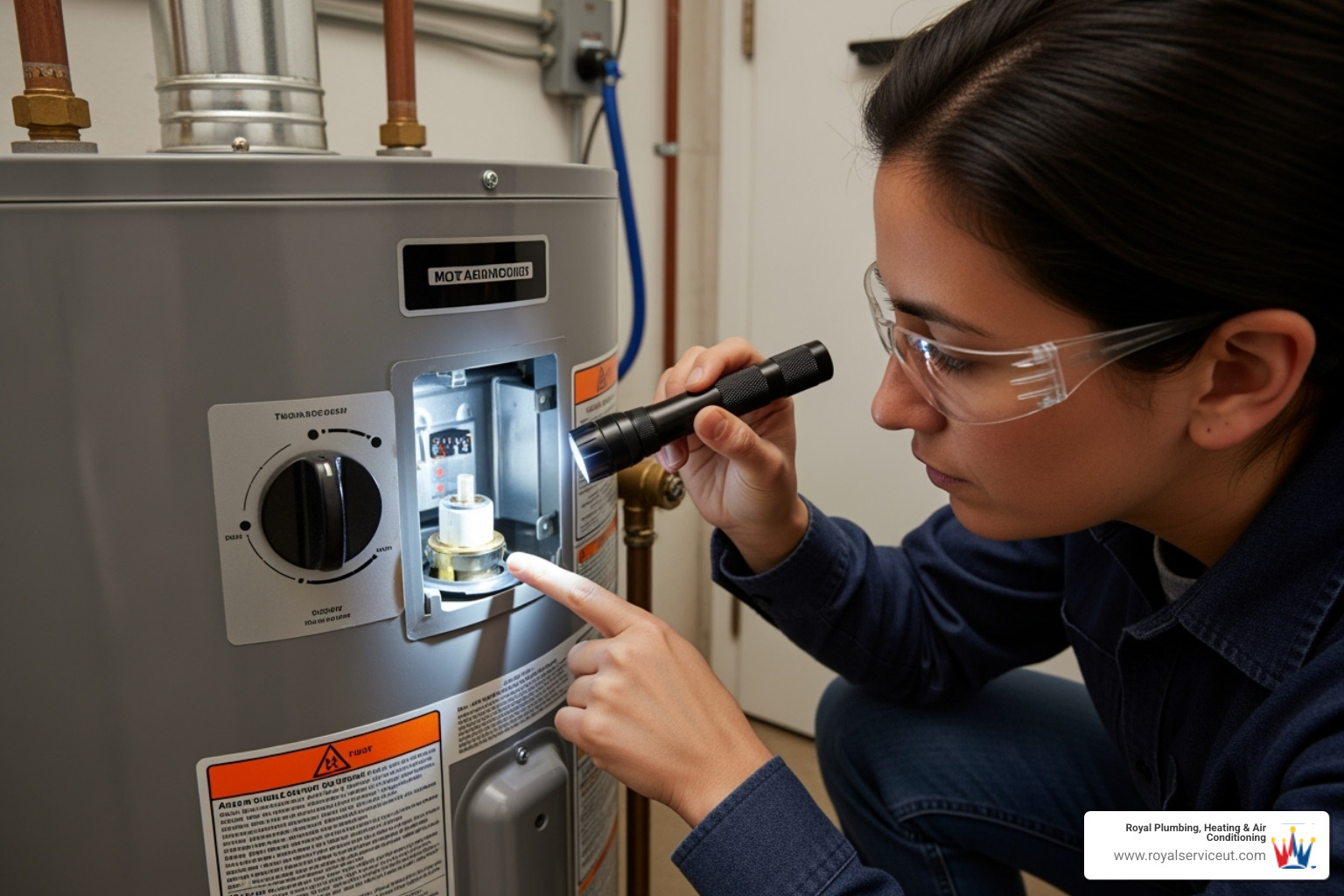
That little pilot light flame might seem insignificant, but it's the heart of your gas water heater. When it goes out, your entire hot water supply disappears with it. Before we dive into relighting it, we need to talk safety first.
If you smell gas - and we're talking about that distinctive rotten egg smell - stop everything right now. Don't flip any switches, don't light any matches, and definitely don't try to relight the pilot. Turn off the gas at the main shut-off valve if you can do so safely, get everyone out of the house, and call your gas company from outside. Gas leaks are nothing to mess around with.
No gas smell? Great! Let's get that pilot light going again. Start by turning the gas control knob to the "off" position and give it a good 5-10 minutes to let any lingering gas clear out. This waiting period might feel like forever when you're eager for hot water, but it's crucial for safety.
Next, find the access panel near the bottom of your water heater - it's usually a small door or removable cover that gives you a view of the pilot light and burner area. Remove this panel so you can see what you're working with.
Now comes the actual relighting process. Turn your gas control knob to the "pilot" setting and press it down. This allows gas to flow to the pilot light. While holding the knob down, use a long lighter or match to ignite the pilot flame. If your water heater has a built-in igniter button, even better - just press that instead.
Here's the key part: once the pilot lights, keep holding that gas control knob down for about 30-60 seconds. This gives the thermocouple time to heat up and signal that there's actually a flame present. If you let go too soon, the pilot will just go out again, and you'll be back to square one.
When you finally release the knob, the pilot should stay lit. If it goes out immediately, try the whole process again. Once the pilot stays lit reliably, turn the gas control knob from "pilot" to the "on" position. You should hear the satisfying whoosh of the main burner igniting, and your hot water production will resume.
For detailed instructions specific to your model, check your owner's manual - different manufacturers sometimes have slightly different procedures. And if you're not comfortable with any of this, don't hesitate to get help from our team. We've seen it all when it comes to pilot light issues.
Sometimes the pilot light isn't the villain in your no hot water story. Let's look at the other usual suspects that can leave you shivering in the shower.
A faulty thermocouple is probably the most common culprit after pilot light problems. This little device acts like a safety guard, constantly checking to make sure your pilot light is actually burning. When it senses a flame, it sends a signal that keeps the gas valve open. When it doesn't sense a flame - or when it's broken and can't sense anything - it shuts off the gas supply faster than you can say "cold shower."
If your pilot light keeps going out no matter how many times you relight it, or if it won't stay lit when you release the gas control knob, the thermocouple is likely worn out. These components do wear out over time, especially in older water heaters.
A defective gas valve can be trickier to diagnose but just as frustrating. This valve controls gas flow to both your pilot light and main burner. When it starts failing, you might find that the pilot lights just fine, but the main burner never kicks in to actually heat your water. Or the valve might not allow any gas through at all, leaving you with no pilot light and no hot water.
Modern gas water heaters often have electronic gas control valves that can fail due to power surges or simply age out. These are more complex than the old mechanical valves and usually require professional replacement.
Clogged burner assemblies might not sound dramatic, but they can definitely ruin your day. Over months and years, dust, pet hair, and other debris can build up around the burner, blocking the gas ports and preventing proper combustion. You might notice that your burner flames look yellow instead of blue, or that they seem weak and uneven.
Don't forget about gas supply issues affecting your whole house. If your gas stove won't light and your furnace isn't working either, the problem isn't with your water heater - it's with your gas supply. This could be anything from a problem with your gas meter to issues with the main gas line serving your home.
When gas supply problems crop up, they're definitely not DIY territory. Our experienced team handles gas line services throughout northern Utah, ensuring your home's gas system is safe and reliable.
Sometimes the reason for no hot water isn't specific to whether you have a gas or electric unit. These universal problems can sneak up on any tank-style water heater, often developing slowly over months or years before they finally leave you shivering in a cold shower.
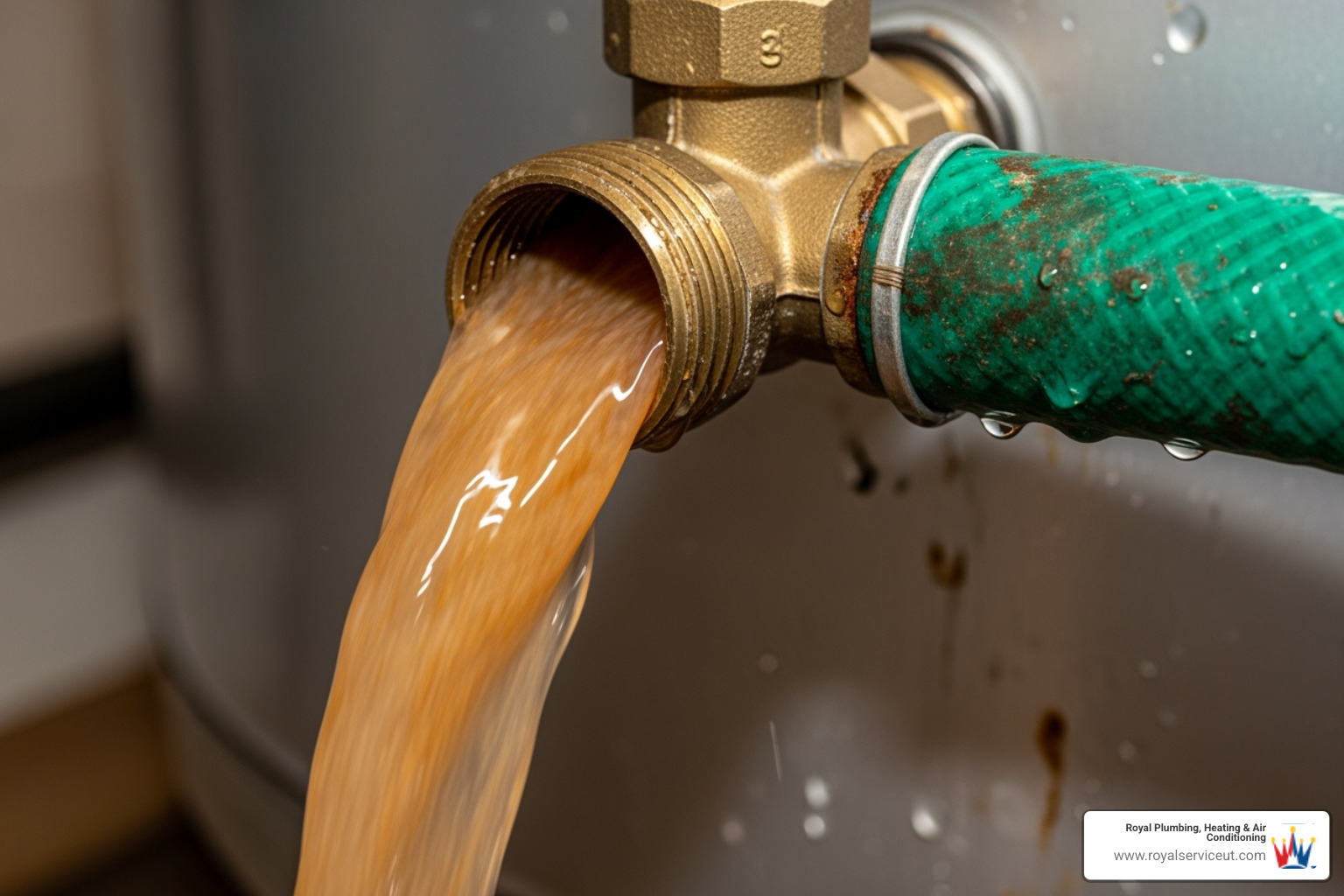
Here in northern Utah, we deal with some pretty hard water, and that means one thing: sediment buildup is practically inevitable in your water heater tank. Think of it as the silent enemy that's been plotting against your morning shower for years.
Every day, tiny mineral deposits from calcium and magnesium in your water settle like snow at the bottom of your tank. Over months and years, this creates a thick, crusty layer that acts like a blanket between your heating source and the water above it. Your poor water heater has to work overtime, burning through energy and struggling to heat water through this mineral barrier.
The first sign you'll usually notice is popping and rumbling sounds coming from your tank. What's happening is pretty fascinating, actually – water gets trapped under that sediment layer, starts boiling, and creates little steam pockets that burst with a pop. It sounds like your water heater is making popcorn, but it's really crying for help.
This sediment doesn't just make noise; it's stealing your hot water capacity. The mineral layer takes up valuable space in your tank, and worse yet, it can clog up your dip tube or interfere with your heating elements. Eventually, all this buildup can lead to reduced efficiency, slower recovery times, and yes, even no hot water at all.
The good news? Flushing your tank annually can prevent most of these problems. It's like giving your water heater a deep clean, washing away all those accumulated minerals before they cause serious trouble. For detailed maintenance guidance or professional service, our team offers comprehensive water heater maintenance to keep your system running smoothly.
Water heaters can fail in ways that have nothing to do with their heating components, and these problems can be just as frustrating when you're facing no hot water.
Water puddles around your tank base are never a good sign. If you spot them, you're likely dealing with corrosion somewhere in the system. Sometimes it's a simple fix – maybe a loose connection or a weeping temperature relief valve. But if that rusted tank itself is leaking, we're talking about replacement territory. After about 10 years of faithful service, tanks can rust through from the inside out, and once that happens, there's no going back.
Here's something that catches many homeowners off guard: your water heater might be working perfectly, but it's simply too small for your family's needs. Maybe you installed it when it was just the two of you, but now you've got teenagers taking marathon showers. An undersized heater will leave you with lukewarm water during peak usage times, making it feel like you have no hot water when you need it most.
The broken dip tube is one of those sneaky problems that can drive you crazy. This plastic tube directs cold water to the bottom of your tank to be heated properly. When it breaks or deteriorates, cold water mixes with your hot water at the top, giving you that frustrating lukewarm experience even though your heating system is working fine.
Don't forget about Mother Nature's role in all this. During our cold Utah winters, that incoming water is significantly chillier than in summer, which means your water heater needs more time and energy to bring it up to temperature. If you're already dealing with an aging or undersized unit, winter can push it over the edge into no hot water territory.
Understanding your household demand and your tank's first-hour rating can help you figure out if sizing is part of your hot water woes. Sometimes the solution isn't fixing what you have – it's upgrading to something that can actually handle your family's needs.
When you're dealing with no hot water, the big question becomes: should you fix what you have or start fresh with a new unit? It's one of those decisions that can feel overwhelming, especially when you're already frustrated by cold showers.
The answer isn't always straightforward, but there are some clear guidelines that can help you make the right choice for your home and budget.
Age is probably the most important factor to consider. If your water heater is approaching or has passed the 10-year mark, replacement often makes more financial sense than repair. Think of it like an old car – at some point, you're throwing good money after bad with constant fixes.
For newer units (under 5 years old), repairs are usually the way to go, especially if the problem is something straightforward like a faulty thermostat or heating element. These components are relatively inexpensive to replace, and you'll likely get several more years of reliable service.
The frequency of repairs tells its own story. If you've called for service multiple times in the past year, or if this is the second major repair in a short period, your water heater is probably trying to tell you something. When repair bills start adding up, replacement becomes the smarter long-term investment.
Cost is always a consideration, but it's not just about the immediate repair bill. A good rule of thumb is the "50% rule" – if the repair costs more than half the price of a new water heater, replacement is usually the better choice. But also consider your energy bills. Older, failing units often work inefficiently, driving up your monthly costs even when they're technically "working."
Tank leaks are almost always a deal-breaker. If water is pooling around the base of your unit, or if you see signs of corrosion and rust on the tank itself, it's time to replace. A leaking tank means the inner lining has failed, and there's no economical way to fix that. It's like trying to patch a hole in a balloon – it might work temporarily, but failure is inevitable.
Energy efficiency is another compelling reason to consider replacement. Modern water heaters are significantly more efficient than units from even 10 years ago. If your current unit is struggling or causing high energy bills, a new efficient model could actually pay for itself over time through reduced operating costs.
Sometimes the decision is made for you. If you're constantly running out of hot water because your family has grown or your usage patterns have changed, repair won't solve the underlying problem. You might need a larger capacity traditional unit or could benefit from upgrading to a tankless system that provides hot water on demand.
For complex issues like no hot water caused by multiple failing components, replacement often makes more sense than trying to fix everything piecemeal. When both heating elements are shot, the thermostat is acting up, and there's sediment buildup, you're looking at significant repair costs that might approach replacement costs anyway.
The good news is that modern water heaters offer features that weren't available years ago. Better insulation, more precise temperature controls, and longer warranties all add value. Some newer models even have smart features that can alert you to problems before they leave you without hot water.
If you're unsure about the best path forward, our experienced team at Royal Plumbing, Heating & Air Conditioning can help you evaluate your specific situation. We'll assess your current unit, explain your options clearly, and help you make a decision that makes sense for your home and budget. Whether you need more info about water heater replacement or want to explore more info about tankless water heaters, we're here to guide you through the process.
A water heater replacement isn't just about fixing today's no hot water problem – it's an investment in years of reliable, efficient hot water for your family.
Find answers to frequently asked questions about our services.
By reading this blog post, you will gain valuable insights and knowledge that can help you in your daily life.
The purpose of this blog post is to inform and educate readers about a specific topic, providing them with useful information and tips.
The target audience for this blog post includes individuals who are interested in learning more about the topic and seeking practical advice.
You can apply the knowledge and tips shared in this blog post to your own life by implementing them in your daily routine.
The benefits of reading this blog post include gaining new perspectives, acquiring practical skills, and enhancing your overall knowledge on the topic.
Absolutely! Feel free to share this blog post with your friends, family, or anyone who might find it helpful or interesting.
Yes, the information provided in this blog post is reliable and based on credible sources. We strive to ensure the accuracy and quality of the content we share.
The benefits of reading this blog post include gaining new perspectives, acquiring practical skills, and enhancing your overall knowledge on the topic.
If you have more questions related to the blog post topic, please don't hesitate to contact our team. We're here to help!
We value your feedback! If you have any suggestions, comments, or feedback regarding this blog post, please let us know. Your input is important to us.
Trust our team of dedicated professionals for all your HVAC and plumbing needs.